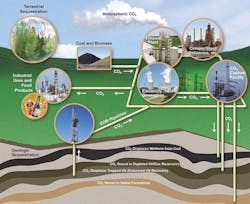DOE marking $131M toward Carbon Capture, Storage and Use R&D
If there are many paths to Net Zero goals beyond solar, wind and energy storage, the greenhouse gas reductions could become less sexy and new, but certainly contributive technologies such as nuclear and carbon capture.
The latter, often derided by environmental groups as a dirty and ineffective backdoor way to keep coal-fired and gas-fired power generation going, is gaining increased currency within the U.S. Department of Energy. Earlier this week, DOE announced $131 million in funding for 33 research and development projects aimed at eventual scaled-up deployment of carbon management technologies.
The DOE’s move follows earlier announcements of carbon capture projects involving companies as varied as steel maker ArcelorMittal, building materials firm Lehigh Hanson, oil and gas producers Shell and Occidental as well as more niche entities such as the NFL’s Houston Texans and real estate developments.
CCUS (carbon capture utilization and storage) has its believers, for sure. And some of them work for the government.
“By deploying tools to capture, remove and store CO2 emissions, we can dramatically reduce the air pollution harming our health and intensifying extreme weather events,” Biden administration’s Secretary of Energy Jennifer Granholm said in a statement. “The projects...will get us closer to achieving our climate goals while helping to revitalize local economies and deliver environmental benefits to communities too often left behind.”
Carbon capture and carbon removal efforts could eliminate hundreds of millions of metric tons in C02 pollution annually, according to the DOE.
A $38 million portion of the funding will go to 22 projects under the “Carbon Management” sector, either capturing the carbon dioxide from utility and industrial resources or directly from the atmosphere (direct air capture). The CO2 could then be transported for permanent geologic storage or conversion into valuable products such as carbon fiber, fuels and chemicals.
Among the DOE recipients under the carbon management sector include R&D projects at Washington University in St. Louis, Ohio University, University of Illinois, TDA Research Inc., Holocene Climate Corp., Georgia Tech and others.
The remaining $93 million will go toward 11 projects under the “CarbonSAFE: Phase 11—Storage Complex Feasibility” section. These projects are trying to improve the assessment of onshore and offshore CO2 projects sites at commercial scale.
CarbonSAFE stands for Carbon Storage Assurance Facility Enterprise. Among those projects selected included R&D work by Advanced Resources International, Battelle Memorial Institute, Gas Technology Institute, Port of Corpus Christi Authority and more.
To see the full lists on the DOE site, click here. DOE’s National Energy Technology Laboratory will manage the selection projects.
To read more of EnergyTech’s complete coverage of carbon capture, utilization and storage efforts in the commercial and industrial sectors, click here.
Multiple sectors in the U.S. combined emit more than 5,100 million (5.1 billion) metric tons of CO2 into the atmosphere every year, according to the federal Energy Information Administration. Those include the electricity, transportation, buildings and industrial production sectors.
The United States Geological Survey estimates that some 3,000 metric gigatons of CO2 could safely be stored within the nation’s boundaries. Those potential carbon storage sites are all at least 3,000 feet below ground surface, according to the USGS.
The U.S. Gulf Coast represents nearly 60 percent of national CO2 storage capacity, the USGS says.
-- -- --
(Rod Walton, senior editor for EnergyTech, is a 15-year veteran of covering the energy industry both as a newspaper and trade journalist. He can be reached at [email protected]).
Follow us on Twitter @EnergyTechNews and @rodwaltonelp and on LinkedIn.
About the Author
Rod Walton, EnergyTech Managing Editor
Managing Editor
For EnergyTech editorial inquiries, please contact Managing Editor Rod Walton at [email protected].
Rod Walton has spent 17 years covering the energy industry as a newspaper and trade journalist. He formerly was energy writer and business editor at the Tulsa World. Later, he spent six years covering the electricity power sector for Pennwell and Clarion Events. He joined Endeavor and EnergyTech in November 2021.
Walton earned his Bachelors degree in journalism from the University of Oklahoma. His career stops include the Moore American, Bartlesville Examiner-Enterprise, Wagoner Tribune and Tulsa World.
EnergyTech is focused on the mission critical and large-scale energy users and their sustainability and resiliency goals. These include the commercial and industrial sectors, as well as the military, universities, data centers and microgrids. The C&I sectors together account for close to 30 percent of greenhouse gas emissions in the U.S.
He was named Managing Editor for Microgrid Knowledge and EnergyTech starting July 1, 2023
Many large-scale energy users such as Fortune 500 companies, and mission-critical users such as military bases, universities, healthcare facilities, public safety and data centers, shifting their energy priorities to reach net-zero carbon goals within the coming decades. These include plans for renewable energy power purchase agreements, but also on-site resiliency projects such as microgrids, combined heat and power, rooftop solar, energy storage, digitalization and building efficiency upgrades.

